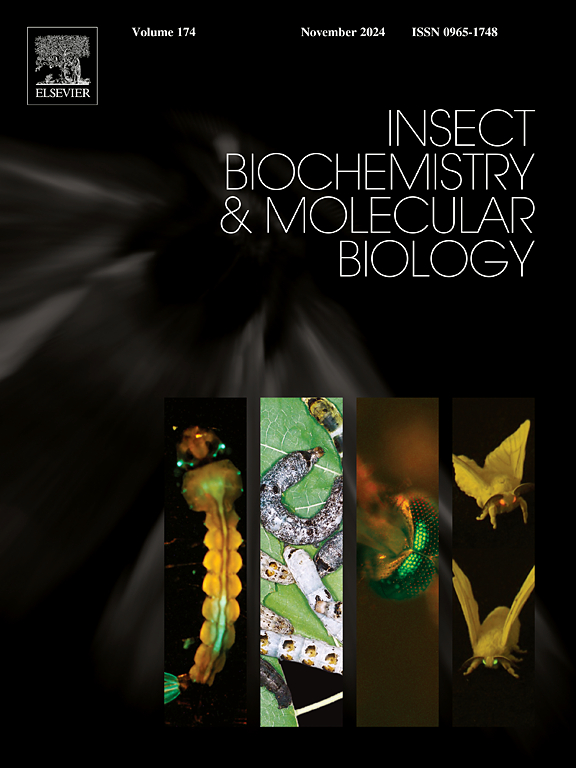Molecular and pharmacological characterization of the dopamine receptors in the oriental fruit fly, Bactrocera dorsalis
IF 3.7
2区 农林科学
Q2 BIOCHEMISTRY & MOLECULAR BIOLOGY
引用次数: 0
Abstract
Dopamine (DA) is a critical molecule within the insect nervous system, known to regulate a myriad of physiological functions and instigate behavioral shifts in insects. It exerts its effects by interacting with specific dopamine receptors (DARs). In this study, three DARs cDNAs from Bactrocera dorsalis (Hendel) (Diptera: Tephritidae) (BdDOP1, BdDOP2 and BdDOP3) were cloned using molecular biology techniques. These receptors exhibited high sequence identity with their orthologous DARs, and phylogenetic analyses also clustered these receptors within their respective receptor subtype. Additionally, the high expression levels of these DARs in the head suggest their prominent role in the central nervous system of B. dorsalis. To investigate the pharmacological properties of these receptors, expression vectors for BdDOP1, BdDOP2 and BdDOP3 were constructed and expressed in HEK-293T cells. Our results demonstrated that DA and synthetic agonists activated these receptors in a dose-dependent manner, and DA activation can be competitively inhibited by various antagonists, exhibiting distinct potencies for each dopamine receptor type. Among the tested antagonists, SCH-23390, methiothepin, and metoclopramide were identified as the most potent inhibitors of BdDOP1, BdDOP2 and BdDOP3, respectively. This study provides valuable insights into the molecular and pharmacological characteristics of DARs in B. dorsalis, offering a theoretical foundation for the development of novel behavioral modulators targeting these receptors. The findings also serve as a reference for the functional analyses of DARs in other insect species.

桔小实蝇多巴胺受体的分子和药理研究
多巴胺(DA)是昆虫神经系统中的一种重要分子,众所周知,它能调节昆虫的各种生理功能并促使其行为发生转变。它通过与特定的多巴胺受体(DARs)相互作用来发挥其作用。在这项研究中,利用分子生物学技术克隆了 Bactrocera dorsalis (Hendel) (Diptera: Tephritidae) 的三种 DARs cDNA(BdDOP1、BdDOP2 和 BdDOP3)。这些受体与其同源的 DARs 具有很高的序列同一性,系统进化分析也将这些受体归入各自的受体亚型。此外,这些 DARs 在头部的高表达水平表明,它们在背壳虫的中枢神经系统中发挥着重要作用。为了研究这些受体的药理特性,我们构建了 BdDOP1、BdDOP2 和 BdDOP3 的表达载体,并在 HEK-293T 细胞中进行了表达。我们的研究结果表明,DA和合成激动剂能以剂量依赖的方式激活这些受体,而各种拮抗剂能竞争性地抑制DA的激活,并对每种多巴胺受体类型表现出不同的效力。在测试的拮抗剂中,SCH-23390、甲硫哒嗪和甲氧氯普胺分别被确定为 BdDOP1、BdDOP2 和 BdDOP3 的最强抑制剂。这项研究为深入了解背带蝠 DARs 的分子和药理学特征提供了宝贵的资料,为开发针对这些受体的新型行为调节剂奠定了理论基础。研究结果也为其他昆虫物种的 DARs 功能分析提供了参考。
本文章由计算机程序翻译,如有差异,请以英文原文为准。
求助全文
约1分钟内获得全文
求助全文
来源期刊
CiteScore
7.40
自引率
5.30%
发文量
105
审稿时长
40 days
期刊介绍:
This international journal publishes original contributions and mini-reviews in the fields of insect biochemistry and insect molecular biology. Main areas of interest are neurochemistry, hormone and pheromone biochemistry, enzymes and metabolism, hormone action and gene regulation, gene characterization and structure, pharmacology, immunology and cell and tissue culture. Papers on the biochemistry and molecular biology of other groups of arthropods are published if of general interest to the readership. Technique papers will be considered for publication if they significantly advance the field of insect biochemistry and molecular biology in the opinion of the Editors and Editorial Board.

 求助内容:
求助内容: 应助结果提醒方式:
应助结果提醒方式:


